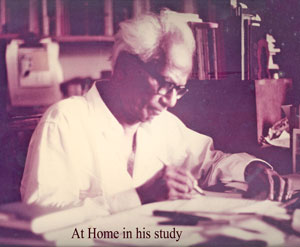|
118th birth anniversary:
The Sage of Koggala
Ruwini Jayawardana
|

At home in his study
|
Martin Wickramasinghe has carved a niche in history for his
contribution to the world of literature, but his role as a literary
genius has eclipsed the pioneering contributions he has made towards the
education in depth of our swabasha intelligentsia in fields as diverse
as biology, anthropology, archaeology Eastern and Western philosophy,
sociology and comparative religion.
Martin Wickramasinghe's bilingual skills and knowledge enabled him to
revolutionize the thinking process of the Sinhala educated
intelligentsia. Time, and the critical evaluation of academics both in
Sri Lanka and internationally, have confirmed the high quality of his
writings. This article is aimed at bringing out some aspects of the
non-fictional writings of Sri Lanka's legendary genius.
Martin Wickramasinghe's early writings in biology were in the nature
of ecological studies based on personal observation of the sea, the
Koggala Oya and the village hinterland, and reading related to questions
raised by what he saw. These essays revealed remarkable facts relating
to the backdrop of the rural village.
Although there were a lot of English publications related to Science
and Biology during the 1930's and later, there was no way for the Sri
Lankan Sinhala educated society to gain knowledge in these subjects.
Wickramasinghe noted this vacuum and wrote a series of essays focused
on insects and plants which he put together in the series "Vidya Vinoda
Katha". These were popular science writings meant for children, but they
highlighted many little known facts that are fascinating to us even
today.
An example is his description of the 'Ra Badulla' and its ability to
inject an anaesthetizing substance into the brain of the snail on which
it preys.
Martin Wickramasinghe introduced Charles Darwin's theory of evolution
to the Sinhala educated intelligentsia as far back as 1933 with his book
'Sathwa Santhatiya'.
|

The house at Koggala where Wickremesinghe was born forms an
integral part of the Museum of Folk Culture named after him. |
This was not a translation but an original presentation of the impact
of Darwin's theory, not only on the evolution of plants and animals, but
also on the evolution of man and society. In writing this book, he had
to coin terms in Sinhala that would be meaningful to the Sinhala reader.
In 'Sathwa Santhathiya', he has listed a reference literature of over
seventy titles he had read. These books, with penciled annotations, can
still be seen in the Martin Wickramasinghe Collection housed in the
National Library in Independence Square.
The references include many famous names in Darwinism, such as Julian
Huxley and S.A. Barnett. 'Sathwa Santhathiya' was revised and updated by
him in subsequent editions.
Martin Wickramasinghe had a very close friendship with Professor
Senerath Paranavitane, Sri Lanka's great archaeologist, who often
invited him to join him on his visits to Anuradhapura and Sigiriya.
Martin Wickramasinghe has expressed some original views in the field of
archaeology.
In one of his essays in English, 'Aspects of Sinhalese Culture', he
raises a question regarding Professor Senerat Paranavitana's conjecture,
based on a rock inscription, that the Ran Masu Uyana (Gold Fish Park) in
Anuradhapura was so named after a rock basin in which gold-fish imported
from China were bred. The archaeological evidence is that Ran Masu Uyana
was in existence before the tenth century.
Martin Wickramasinghe points out, on the other hand, that according
to the biologist Professor E.W. Macbride, the Chinese records described
the gold fish for the first time in China in the twelfth century. Martin
Wickramasinghe raises the question whether the Sri Lankan ran masu was
an indigenous variety of fish.
One of his most interesting studies is focused on dwarf figures found
on the capitals of pillars and in terra cota figures in Anuradhapura and
Pollonaruwa.
These figures, which are at times grotesque and at others amusing,
are depicted in all manner of activities from music to dancing, and
plain mischief. Wickramasinghe quotes the archaeologist H.C.P.Bell's
comments: "For a more jovial band, male and female it would be hard to
find anywhere, jostling one another, jesting and sporting the while,
with all the exuberant good-natured conviviality which marks crowds on
pleasure bent."
|

Martin Wickramasinghe in Darwin’s study in Dowin house |
Wickramasinghe points out that the dwarf figures can provide
interesting information for sociological studies of the past.
Wickramasinghe had the ability to relate information from diverse
fields of knowledge in this manner. His bilingual diversity of knowledge
is evidenced by the personal reference library of more than 5,000 titles
he had collected over a period of sixty years, now housed in the
National Library.
The key to his success was his constant curiosity to ask questions
about accepted views, which he has attributed to the Buddhist tradition
to question tradition, that is part of our cultural heritage.
Wickramasinghe focused on anthropology when the English culture was
flaunted as superior to our own, at a time when many of our leaders
imitated the elitist lifestyle of the British. He refers to the
anthropological perception that cultures cannot be graded into superior
and inferior.
His love for the rural way of life is evident in his writings. He
instilled a sense of dignity and pride in our own way of life by
introducing his writings inspired by cultural anthropology, to the
Sinhala educated intelligentsia.
I would like to acknowledge his son, Dr. Ranga Wickramasinghe for
helping me find the sources that made this article possible. |

